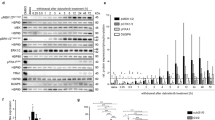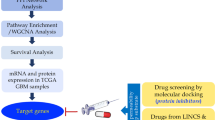Abstract
Recent progress in cancer biology indicates that eradication of cancer stem cells (CSCs) is essential for more effective cancer therapy. Unfortunately, cancer stem cells such as glioma stem-like cells (GSLCs) are often resistant to either radio- or chemotherapy. Therefore, screening and development for novel therapeutic modalities against CSCs has been an important emerging field in cancer research. In this study, we report that a synthetic dl-nordihydroguaiaretic acid compound (dl-NDGA or “Nordy”), inhibited self-renewal and induced differentiation of GSLCs in vitro and in vivo. We found that Nordy inhibited an enzyme known to be involved in leukemia stem cell and leukemia progression, Alox-5, and attenuated the growth of GSLCs in vitro. Nordy reduced the GSLC pool through a decrease in the CD133+ population and abrogated clonogenicity. Nordy appeared to exert its effect via astrocytic differentiation by up-regulation of GFAP and down-regulation of stemness related genes, rather than by inducing apoptosis of GSLCs. The growth inhibition of xenografted glioma by Nordy was more long-lasting compared with that of the akylating agent BCNU, which exhibited significant relapse on drug discontinuation resulting from an enrichment of GSLCs. Meanwhile, transient exposure to Nordy reduced tumorigenecity of GSLCs and induced differentiation of the xenografts. Taken together, we have identified Alox-5 as a novel target in GSLCs and its inhibition with Nordy exhibits therapeutic implications through inducing GSLC differentiation.






Similar content being viewed by others
References
Visvader, J. E., & Lindeman, G. J. (2008). Cancer stem cells in solid tumours: accumulating evidence and unresolved questions. Nat Rev Cancer, 8, 755–68.
Clarke, M. F., Dick, J. E., Dirks, P. B., et al. (2006). Cancer stem cells—perspectives on current status and future directions: AACR Workshop on cancer stem cells. Cancer Res, 66, 9339–44.
Lee, J., Son, M. J., Woolard, K., et al. (2008). Epigenetic-mediated dysfunction of the bone morphogenetic protein pathway inhibits differentiation of glioblastoma-initiating cells. Cancer Cell, 13, 69–80.
Wang, J., Sakariassen, P. O., Tsinkalovsky, O., et al. (2008). CD133 negative glioma cells form tumors in nude rats and give rise to CD133 positive cells. Int J Cancer, 122, 761–8.
Beier, D., Hau, P., Proescholdt, M., et al. (2007). CD133(+) and CD133(−) glioblastoma-derived cancer stem cells show differential growth characteristics and molecular profiles. Cancer Res, 67, 4010–5.
Chen, J. H., Bian, X. W., Yao, X. H., et al. (2006). Nordy, a synthetic lipoxygenase inhibitor, inhibits the expression of formylpeptide receptor and induces differentiation of malignant glioma cells. Biochem Biophys Res Commun, 342, 1368–74.
Bian, X. W., Xu, J. P., Ping, Y. F., et al. (2008). Unique proteomic features induced by a potential antiglioma agent, Nordy (dl-nordihydroguaiaretic acid), in glioma cells. Proteomics, 8, 484–94.
Chen, Y., Hu, Y., Zhang, H., Peng, C., & Li, S. (2009). Loss of the Alox5 gene impairs leukemia stem cells and prevents chronic myeloid leukemia. Nat Genet, 41, 783–92.
Singh, S. K., Clarke, I. D., Terasaki, M., et al. (2003). Identification of a cancer stem cell in human brain tumors. Cancer Res, 63, 5821–8.
Bao, S. D., Wu, Q. L., Sathornsumetee, S., et al. (2006). Stem cell-like glioma cells promote tumor angiogenesis through vascular endothelial growth factor. Cancer Res, 66, 7843–8.
Yu, S. C., Ping, Y. F., Yi, L., et al. (2008). Isolation and characterization of cancer stem cells from a human glioblastoma cell line U87. Cancer Lett, 265, 124–34.
Yi, L., Zhou, Z. H., Ping, Y. F., et al. (2007). Isolation and characterization of stem cell-like precursor cells from primary human anaplastic oligoastrocytoma. Mod Pathol, 20, 1061–8.
Nathoo, N., Prayson, R. A., Bondar, J., et al. (2006). Increased expression of 5-lipoxygenase in high-grade astrocytomas. Neurosurgery, 58, 347–54.
Lim JY, Oh JH, Jung JR, et al. MK886-induced apoptosis depends on the 5-LO expression level in human malignant glioma cells. J Neurooncol 2009.
Ishii, K., Zaitsu, M., Yonemitsu, N., Kan, Y., Hamasaki, Y., & Matsuo, M. (2009). 5-lipoxygenase pathway promotes cell proliferation in human glioma cell lines. Clin Neuropathol, 28, 445–52.
Zhang, L., Zhang, W. P., Hu, H., et al. (2006). Expression patterns of 5-lipoxygenase in human brain with traumatic injury and astrocytoma. Neuropathology, 26, 99–106.
Rajaraman, P., Brenner, A. V., Butler, M. A., et al. (2009). Common variation in genes related to innate immunity and risk of adult glioma. Cancer Epidemiol Biomark Prev, 18, 1651–8.
Aguado, T., Carracedo, A., Julien, B., et al. (2007). Cannabinoids induce glioma stem-like cell differentiation and inhibit gliomagenesis. J Biol Chem, 282, 6854–62.
Ben-Porath, I., Thomson, M. W., Carey, V. J., et al. (2008). An embryonic stem cell-like gene expression signature in poorly differentiated aggressive human tumors. Nat Genet, 40, 499–507.
Somervaille, T. C. P., Matheny, C. J., Spencer, G. J., et al. (2009). Hierarchical maintenance of MLL myeloid leukemia stem cells employs a transcriptional program shared with embryonic rather than adult stem cells. Cell Stem Cell, 4, 129–40.
Wong, D. J., Liu, H., Ridky, T. W., Cassarino, D., Segal, E., & Chang, H. Y. (2008). Module map of stem cell genes guides creation of epithelial cancer stem cells. Cell Stem Cell, 2, 333–44.
Ito, K., Bernardi, R., Morotti, A., et al. (2008). PML targeting eradicates quiescent leukaemia-initiating cells. Nature, 453, 1072–8.
Furstenberger, G., Krieg, P., Muller-Decker, K., & Habenicht, A. J. (2006). What are cyclooxygenases and lipoxygenases doing in the driver’s seat of carcinogenesis? Int J Cancer, 119, 2247–54.
Hyde, C. A., & Missailidis, S. (2009). Inhibition of arachidonic acid metabolism and its implication on cell proliferation and tumour-angiogenesis. Int Immunopharmacol, 9, 701–15.
Peters-Golden, M., & Henderson, W. R., Jr. (2007). Leukotrienes. N Engl J Med, 357, 1841–54.
Pidgeon, G. P., Lysaght, J., Krishnamoorthy, S., et al. (2007). Lipoxygenase metabolism: roles in tumor progression and survival. Cancer Metastasis Rev, 26, 503–24.
Öhd, J. F., Nielsen, C. K., Campbell, J., Landberg, G., Löfberg, H., & Sjölander, A. (2003). Expression of the leukotriene D4 receptor CysLT1, COX-2, and other cell survival factors in colorectal adenocarcinomas. Gastroenterology, 124, 57–70.
Sun, Z., Sood, S., Li, N., et al. (2006). Involvement of the 5-lipoxygenase/leukotriene A4 hydrolase pathway in 7, 12-dimethylbenz[a]anthracene (DMBA)-induced oral carcinogenesis in hamster cheek pouch, and inhibition of carcinogenesis by its inhibitors. Carcinogenesis, 27, 1902–8.
Melstrom, L. G., Bentrem, D. J., Salabat, M. R., et al. (2008). Overexpression of 5-lipoxygenase in colon polyps and cancer and the effect of 5-LOX inhibitors in vitro and in a murine model. Clin Cancer Res, 14, 6525–30.
Cianchi, F., Cortesini, C., Magnelli, L., et al. (2006). Inhibition of 5-lipoxygenase by MK886 augments the antitumor activity of celecoxib in human colon cancer cells. Mol Cancer Ther, 5, 2716–26.
Hammamieh, R., Sumaida, D., Zhang, X., Das, R., & Jett, M. (2007). Control of the growth of human breast cancer cells in culture by manipulation of arachidonate metabolism. BMC Cancer, 7, 138.
Kang, M. K., & Kang, S. K. (2007). Tumorigenesis of chemotherapeutic drug-resistant cancer stem-like cells in brain glioma. Stem Cells Dev, 16, 837–47.
Chen, Y. C., Hsu, H. S., Chen, Y. W., et al. (2008). Oct-4 expression maintained cancer stem-like properties in lung cancer-derived CD133-positive cells. PLoS ONE, 3, e2637.
Gangemi, R. M., Griffero, F., Marubbi, D., et al. (2009). SOX2 silencing in glioblastoma tumor-initiating cells causes stop of proliferation and loss of tumorigenicity. Stem Cells, 27, 40–8.
Takahashi, K., & Yamanaka, S. (2006). Induction of pluripotent stem cells from mouse embryonic and adult fibroblast cultures by defined factors. Cell, 126, 663–76.
Dincbas-Renqvist, V., Pepin, G., Rakonjac, M., et al. (2009). Human Dicer C-terminus functions as a 5-lipoxygenase binding domain. Biochim Biophys Acta, 1789, 99–108.
Godlewski, J., Nowicki, M. O., Bronisz, A., et al. (2008). Targeting of the Bmi-1 oncogene/stem cell renewal factor by microRNA-128 inhibits glioma proliferation and self-renewal. Cancer Res, 68, 9125–30.
Wellner, U., Schubert, J., Burk, U. C., et al. (2009). The EMT-activator ZEB1 promotes tumorigenicity by repressing stemness-inhibiting microRNAs. Nat Cell Biol, 11, 1487–95.
Viswanathan, S. R., Powers, J. T., Einhorn, W., et al. (2009). Lin28 promotes transformation and is associated with advanced human malignancies. Nat Genet, 41, 843–8.
Hambardzumyan, D., Becher, O. J., Rosenblum, M. K., Pandolfi, P. P., Manova-Todorova, K., & Holland, E. C. (2008). PI3K pathway regulates survival of cancer stem cells residing in the perivascular niche following radiation in medulloblastoma in vivo. Genes Dev, 22, 436–48.
Bao, S., Wu, Q., McLendon, R. E., et al. (2006). Glioma stem cells promote radioresistance by preferential activation of the DNA damage response. Nature, 444, 756–60.
Bleau, A. M., Hambardzumyan, D., Ozawa, T., et al. (2009). PTEN/PI3K/Akt pathway regulates the side population phenotype and ABCG2 activity in glioma tumor stem-like cells. Cell Stem Cell, 4, 226–35.
Sell, S. (2006). Cancer stem cells and differentiation therapy. Tumour Biol, 27, 59–70.
Massard, C., Deutsch, E., & Soria, J. C. (2006). Tumour stem cell-targeted treatment: elimination or differentiation. Ann Oncol, 17, 1620–4.
Gupta, P. B., Onder, T. T., Jiang, G., et al. (2009). Identification of selective inhibitors of cancer stem cells by high-throughput screening. Cell, 138, 645–59.
Acknowledgements
We are indebted to Dr. Wei Sun and Dr. Li-ting Wang (Central Laboratory, Third Military Medical University, Chongqing, China) for expertise in immunofluorescence imaging. This work was supported by grants from the National Basic Research Program of China (973 Program, No.2010CB529403) and the national Natural Science Foundation of China (NSFC Nos. 30725035 and 30930103).
Author information
Authors and Affiliations
Corresponding authors
Additional information
This work was supported by grants from the National Basic Research Program of China (973 Program, No.2010CB529403) and the national Natural Science Foundation of China (NSFC Nos. 30725035 and 30930103).
Rights and permissions
About this article
Cite this article
Wang, B., Yu, Sc., Jiang, Jy. et al. An Inhibitor of Arachidonate 5-Lipoxygenase, Nordy, Induces Differentiation and Inhibits Self-Renewal of Glioma Stem-Like Cells. Stem Cell Rev and Rep 7, 458–470 (2011). https://doi.org/10.1007/s12015-010-9175-9
Published:
Issue Date:
DOI: https://doi.org/10.1007/s12015-010-9175-9




